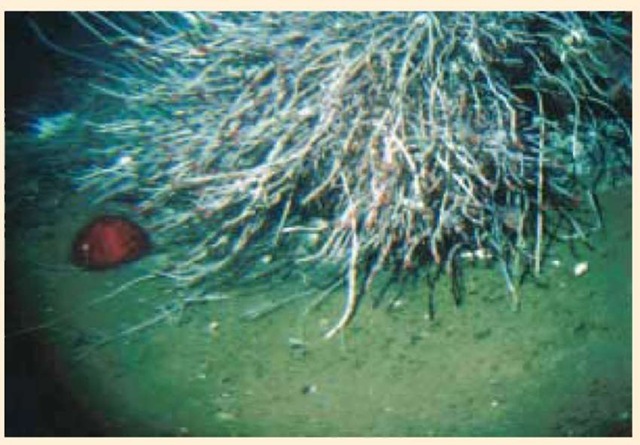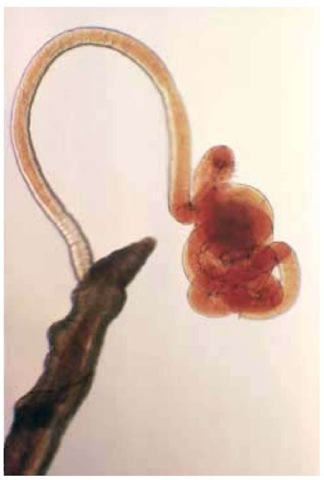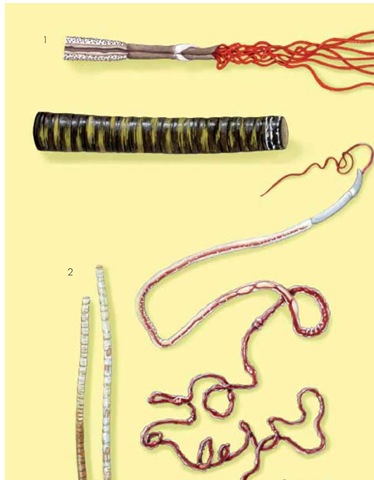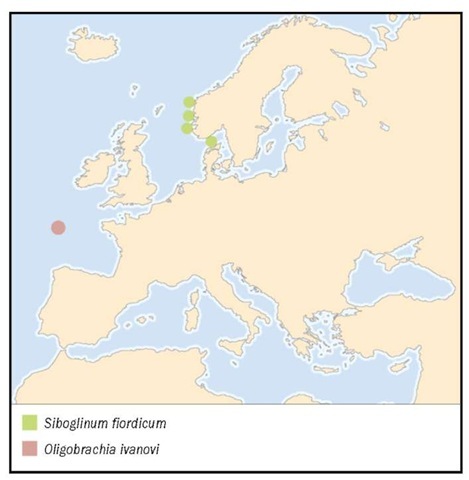Pogonophora
(Beard worms)
Number of families 13
Thumbnail description
Tube-living marine worms nourished by internal chemoautotrophic bacteria.
Photo: Ridgeia piscesae at Middle Valley hydrothermal site in the northeast Pacific Ocean, photographed through the porthole of Alvin, the Navy-owned deep submergence vehicle. The tubes are 0.20-0.39 in (5-10 mm) in diameter.

Evolution and systematics
The name Pogonophora comes from the Greek pogon, meaning “beard,” and phora, meaning “bearing,” and refers to the fact that many species have from one to many tentacles at the anterior end. The earliest known fossil pogonophorans are from the late Cambrian period. About 130 living species of Pogonophora have been described (three subclasses, 13 families, and 29 genera). Their zoological position has been debatable for many years. Their possession of chaetae and intersegmental septa is now considered good evidence of annelid affinity, and DNA analysis supports this, but more work is needed to clarify the position of the Pogonophora within the phylum Annelida. It has been suggested that pogonophores represent a single family of polychaetes (Siboglinidae), but a more conservative classification is used in this chapter.
Pogonophora is divided into the subclasses Frenulata (families Oligobrachiidae, Siboglinidae, Polybrachiidae, Lamellisabel-lidae, and Spirobrachiidae) and Monilifera (family Sclerolinidae, genus Sclerolinum). Some scientists classify Vestimentifera as a subclass of Pogonophora as well, but it is treated separately in this volume. Molecular studies indicate that Frenulata is a sister clade to Vestimentifera plus Monilifera.
Physical characteristics
The tubes the worms produce and live in are unbranched, yellowish, brown, or black, sometimes ring patterned, sometimes segmented. They are made of chitin and protein.
Adult pogonophores have no digestive system. Their body consists of a short anterior region bearing one or more tentaclelike appendages (or branchial filaments), a very long trunk, and a small, segmented, opisthosoma. The body wall consists of cuticle, epidermis, and circular and longitudinal muscles. The coelom is divided into a small cephalic cavity connected to the tentacle coeloms, paired cavities running through the anterior region and trunk, and a series of cavities in the opisthosomal segments, separated by muscular septa. The pogonophoran nervous system consists of an anterior mass of nerve cells, a ventral tract of fibers, and a general network of small fibers, all within the epidermis. The trophosome, a central organ that contains specialized bacteria-containing cells, occupies much of the trunk, sharing the space with the reproductive organs. The vascular system consists of parallel dorsal and ventral vessels and various sinuses connecting them. On the body surface there are cuticular plaques and ridges. The chaetae are internally like those of other annelids, but have unusual dentate heads. They are arranged in low-lying bands rather than in projecting podia.
Frenulates have from one to 200 tentacles; a cuticular ridge, or frenulum, encircling the short, cylindrical, forepart; plaques only on the trunk; chaetae in two well-marked rings about one-third of the way down the trunk; and only four chaetae per segment on the small opisthosoma. Trophosome tissue is absent from the anterior third of the trunk, which is occupied by the reproductive organs.
Moniliferans are extremely thin. They have only two tentacles, a ring of plaques on the anterior body region, and scattered plaques on the long trunk. They have no obturaculum or frenulum. Chaetae may occur in two sparse bands at the hind of the trunk, but are more numerous on the opisthoso-mal segments. Trophosome tissue is restricted to the posterior half of the trunk.

The anterior end and tentacles of Siboglinum fiordicum.
Distribution
Frenulates occur on continental slopes and deep trenches in the Atlantic (including Norwegian fjords), Pacific, Indian, Arctic, and Antarctic Oceans. Moniliferans occur in Norway, the Caribbean, the Southeast Pacific, and the Antarctic.
Habitat
Frenulates live in reducing sediments, with the top of the tube in the overlying oxygenated water. Moniliferans occur in decaying wood on volcanic seeps on the sea floor.
Behavior
The tentacles or branchial plume may be extended from the tube, particularly by vestimentiferans; the animals can retract quickly when disturbed by predators such as crabs. Main activities are gas exchange and tube building.
Feeding ecology and diet
An unusual type of hemoglobin in the blood binds both oxygen and sulfide and transports them to the trophosome. There, the symbiotic bacteria oxidize sulfide to produce chemical energy, which enables them to fix carbon dioxide and manufacture organic compounds. This chemosynthetic process makes pogonophorans virtually independent of light-based photosynthesis as a source of food. The bacteria produce glucose and amino acids, which can be transferred to the host cells directly, or derived from intracellular digestion of some of the bacteria. One frenulate species, Siboglinum posei-doni, lives in methane-rich conditions and utilizes methane with the aid of methanotrophic bacteria.
Reproductive biology
Frenulate males expel spermatophores that drift, become entangled on other tubes, then disintegrate to release longheaded sperm that fertilize the oocytes inside the female oviduct. Females produce either large eggs (around 400 microns) that are incubated in their tubes, or small eggs (around 150 microns) that may develop into pelagic larvae. Large eggs develop into ciliated larvae, which emerge from the maternal tube, then rapidly burrow deep into the sediment and form their own tubes. The symbiotic bacteria are acquired during the settlement stage, and the trophosome then starts to develop.
In moniliferans, Sclerolinum brattstromi males produce free sperm, and eggs are incubated by the female for a few days; later development is unknown. Asexual reproduction by fragmentation occurs.
Conservation status
No species of Pogonophora are listed by the IUCN.
Significance to humans
Pogonophorans are of great interest for scientific research.

1. Black oligobrachia (Oligobrachia ivanovi); 2. Norwegian tubeworm (Siboglinum fiordicum).
Species accounts
Norwegian tubeworm
Siboglinum fiordicum
ORDER
Athecanephria
FAMILY
Siboglinidae
TAXONOMY
Siboglinum fiordicum Webb, 1963.
OTHER COMMON NAMES
None known.
PHYSICAL CHARACTERISTICS
Body diameter 0.009 in (0.25 mm); maximum length 11.8 in (300 mm). One pinnulate tentacle. Tube diameter 0.01 in (0.27 mm); maximum length 11.8 in (300 mm); gray or brown ring pattern, no segmentation.
DISTRIBUTION
Norway.
HABITAT
Muddy sand or mud in fjords or continental shelf; depth range 82-656.7 ft (25 to 200 m), in muddy sand or mud.
BEHAVIOR
Uses opisthosoma to burrow into sediment.
FEEDING ECOLOGY AND DIET
Symbiosis with chemosynthetic bacteria.
REPRODUCTIVE BIOLOGY
CONSERVATION STATUS
Not listed by the IUCN.
SIGNIFICANCE TO HUMANS
The most accessible frenulate species for scientific study.
Black oligobrachia
Oligobrachia ivanovi
ORDER
Athecanephria
FAMILY
Oligobrachiidae
TAXONOMY
Oligobrachia ivanovi Southward, 1959.
OTHER COMMON NAMES
None known.
PHYSICAL CHARACTERISTICS
Body 0.015-0.02 in (0.4-0.6 mm) diameter, at least 7.87 in (200 mm) long; brown with white patches and black stripes. Five to 7 separate pinnulate tentacles; red and orange. Tube 0.015-0.04 in (0.4-1.1 mm) diameter; black with transparent anterior end, wrinkled surface, no segmentation.
DISTRIBUTION
Bay of Biscay (northeast Atlantic).
HABITAT
Mud on steep canyon slopes, at depths to 4,265-8,202 ft (1,300-2,500 m).
BEHAVIOR
Burrowing.
FEEDING ECOLOGY AND DIET
Symbiosis with chemosynthetic bacteria.
REPRODUCTIVE BIOLOGY
Incubates embryos.
CONSERVATION STATUS
Not listed by the IUCN.
SIGNIFICANCE TO HUMANS
None known.

